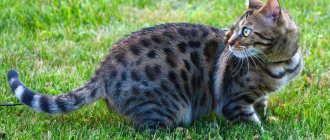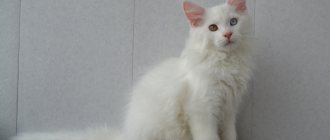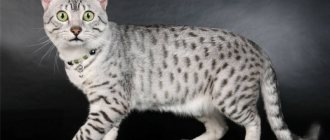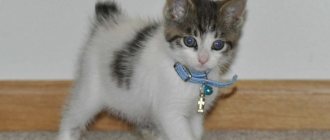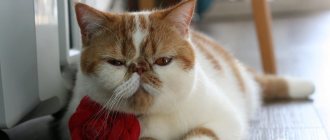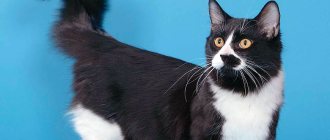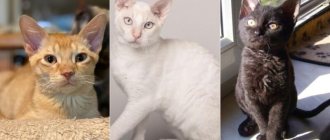Origin story
The Arabian Mau (Arabian Mau) is one of the oldest native breeds.
More than a thousand years ago, their ancestors hunted in the hot sands of the Middle East - hardy, strong, wild, like nature itself. They perfectly knew how to do without human help, cope with the scorching sun, heat and lack of water. However, over time, cities and villages began to appear on the lands where cats lived. Animals visited human habitation more and more often: first out of curiosity, and later, having found out that there was plenty of water and food there - and out of personal interest.
Hundreds of free-loving felines were shuttling between Kuwait, Oman, Qatar and the United Arab Emirates.
For a long time, little attention was paid to them: Persian, Siamese, and Burmese cats gained popularity. But in 2004, the president of the Middle Eastern Cat Society, Petra Müller, captivated by the equanimity and calmness of furry strays, launched a breeding program for Arabian Mau. By 2008, an official standard was developed, the breed was recognized by the WCF association, and in 2009 the first exhibition with their participation took place.
Interesting facts about the Arabian Mau
Homeless Arabian Mau have long infested Turkey in incredible numbers. The threat of human infection with toxoplasmosis (read about this disease in cats and people) and rabies forced the Turkish government to take extreme measures and decide to exterminate stray animals.
After numerous protests from citizens of the country (after all, pets also suffered) and the Animal Welfare Society, the number of these cats in the country is regulated through sterilization, vaccination and microchipping of stray Arabians.
In addition, with the wholesale destruction of these ideal natural hunters, a rapid increase in the rat population began; their spread could cause an even greater epidemiological threat.
This is most likely the only cat breed that feels so comfortable in hot climates. The Arabian Mau is able to survive even in the desert.
Standards
Representatives of this breed look larger than ordinary cats. Males weigh 7-8 kg, females - 4-5.
| Standard | Description |
| Head | Shaped like an elongated wedge, with a noticeably elongated profile and a defined chin that protrudes slightly forward. The whisker pads are well developed, the forehead is narrow and flat. |
| Nose | Medium size. |
| Ears | Large, stand upright, ears slightly turned to the sides. The tips are much narrower than the base, rounded. Both inside and outside are covered with fur. |
| Eyes | Large, almond-shaped, the color matches the shade of the coat. The purer and brighter the color, the higher the value of the animal. The outline is outlined in dark. |
| Torso | Muscular, lean, fit, medium size. Neck: Long and elongated. Limbs are long and straight. The paws are elongated, with elastic and pale pads. |
| Tail | Equal to the length of the body, even, tapering towards the end. The tip is smoothed. |
| Wool | Tough, short, close to the body. The undercoat is completely absent. In babies and young animals (up to 18 months), thin and soft hair is allowed. |
The disqualifying signs are as follows:
- Small body size;
- Short legs;
- Too soft wool (including silky);
- Underdeveloped limbs;
- Round muzzle;
- A different eye shape.
Unfortunately, it is impossible to buy a kitten of this breed in Russia, Belarus or in European countries. The reason is banal: due to the fact that this breed was recognized quite recently, there is only one nursery so far - in Dubai, with the above-mentioned Petra Muller. This breed is not yet widespread outside Arab countries (and, by the way, many felinological organizations do not recognize this breed at all). The price for a kitten starts from 60 thousand rubles and depends on the pedigree, gender of the kitten and class (breed, show, pet).
Breed standard
The felinological European WCF system gives the following description of the reference specimens of the Arabian Mau.
Head
It has the shape of a rounded modified wedge. The profile is elongated, the chin is well formed, the whisker pads are moderately developed. Short nose. The forehead is flat and narrow.
Eyes
Large, oval-shaped, not very widely spaced. The color matches the coat color. Preference is given to clear and pure shades.
Ears
Quite large, widely spaced and located slightly at an angle to the base of the skull. Gradually taper to a rounded tip. They have an internal and small external edge.
Body
Medium size, fit, moderately lean, the muscles of an athlete. The neck is of medium length and strong.
Paws
Long, slender, straight, with well-developed lean muscles. The pads are elongated and stable.
Tail
The proportions correspond to the length of the body, wide at the base and tapering to a rounded tip.
Wool
Short and stiff, lying close to the body. There is no undercoat. Finer and softer hair is acceptable in kittens up to 18 months.
Color
Numerous and varied. The most common, also characteristic of the Turkish Van, is red with white spots.
Red with white
Solid colors (i.e. solid, uniform) are extremely rare, for example, anthracite-black (it should not have a rusty tint), pure snow, red (red), brown, gray. Bicolor, tabby (with spots or stripes), and tortie (tortoiseshell) colors are also common.
Anthracite black
Pure snow
Two types of red Mau tabby
The Arabian Mau is especially beautiful with its silver spotted color.
Silver with spots
Weight
This is a medium sized cat. The weight of females is 4-6, males 7-8 kilograms.
Matings
Only intrabreeds. Read about mating cats and female cats.
Disqualification criteria
Animals are not accepted to participate in exhibitions with the following deficiencies:
- excessive thinness;
- weak limbs;
- too graceful physique;
- excessively delicate and silky wool;
- small sizes.
Photo gallery of Arabian Mau:
Colors
There are many acceptable colors. The most common red and white species is tabby (mackerel or spotted). The amount of white is not regulated.
Other colors:
- Black (without any “rust”). A shiny sheen increases the price of a cat.
- White (also without a hint of yellow).
- White and black (in any proportions).
- Brown tabby (mackerel or spotted).
- White or gray tabby.
In the photo there are cats of the Arabian Mau breed of popular colors
Character and behavior
Cats of this breed are freedom lovers. When he gets into a family, he will choose a main one, more similar to him in temperament, but a friend, not a leader. The genetic memory of Arabian cats does not allow them to relax in a home full of amenities, where there is no need to fight for survival or dominance. They do not tolerate violence, rudeness and restrictions, but they will never allow themselves to do dirty tricks on the sly, look down on everyone or show aggression towards those who are clearly weaker.
These cats have an amazing mind and just great patience. They love to observe those around them, noticing all their actions and actions. They treat household members kindly, but they will only be obedient to those who have authority over them. They treat children with respect and understanding, but if a child pulls the cat’s tail over and over again, they will first hiss and then swing.
They treat the dogs living in the house well and can even make friends. Cats are a completely different matter (especially cats). The Mau does not tolerate rivals. It perceives hamsters and other small rodents as prey, so you should not house them in the same area.
Playful and active cats will respond to the call to play and run at any time. They need activity like air. Therefore, try to immediately create comfortable conditions for the cat. First, buy him a cat play set, and a bigger one. The Arabian Mau loves heights, jumping and climbing up and down, and the complex will help him throw out excess energy and stretch his muscles. Secondly, daily walks are a must if you want your cat to be healthy and happy. Mau walk well on a harness and behave sedately and composedly during walks.
Does your pet like to go for walks?
HomebodyWalking on the street
They quickly learn to go to the litter box and sharpen their claws on a special scratching post, and eat in one place and at the designated time. They will not beg for food at night; during the “rutting season” they behave calmly, without running around.
Arabian Mau are silent cats. But at the same time they are able to convey both emotions and desires with their gaze. They don’t like to sit on their knees or hang on their hands; they prefer to sit next to them and watch TV with the person, or watch the person read or knit.
He behaves like a king with guests: he slowly comes up to introduce himself, graciously allows himself to be stroked, and leaves just as majestically. He will not play with strangers, nor will he take food from strangers.
Researchers are by nature and will explore every corner of the home. You won’t be afraid to jump out of a window, so you should worry about protective nets on the glass.
Character
As children, Arabian Mau are very playful and sociable. But the older the cat gets, the more she likes peace and independence. In general, this is a very good-natured breed without a hint of aggression. They are equally friendly with all family members, get along well with small children, and feel quite comfortable in the company of other cats and even dogs.
Mau love heights and always choose higher places to rest. It is not uncommon to spot a cat sleeping on a table or even on a refrigerator. They also love being outdoors. If you have your own house with a large yard, then this is simply an ideal home for the Arabian Mau. However, if you live in a city apartment, this is not a reason to refuse an Arabian beauty. These cats adapt well to any environment. But in this case, you will need to take your pet for walks.
Care instructions
It is enough to comb Mau 2-3 times a week: first with a slicker brush, and then with a brush with rubber bristles. During shedding, you will have to brush more often - 5 times a week.
Bathing
Mau have nothing against bathing, but they should not be bathed often (otherwise their skin will begin to suffer from inflammation and irritation). Use a special shampoo - liquid, powder or spray (Perfect Coat Waterless Shampoo, Beaphar Grooming Powder, Jerob Texturizing Spray, Espree ShowStyle WIRED TEXTURING Spray, BioGroom Silky Cat Protein-lanolin, Beaphar ProVitamin Shampoo Macadamia Oil).
Claws
Claws are trimmed as they grow, if the cat herself cannot sharpen them properly.
Eyes
The eyes are wiped every day using a cotton sponge or a piece of cotton cloth soaked in eye care lotion (chlorhexidine, fresh chamomile decoction, weak black tea).
Pictured are kittens of the Arabian Mau breed.
Teeth
Teeth are brushed once every 3 days with a special brush and cat toothpaste (without fluoride and aggressive components). Both can be purchased at a pet store. As a last resort, you can buy a children's toothbrush (shorten the bristles before brushing) or wrap your finger in a piece of gauze.
Ears
You need to clean your ears once every 7 days. Take a cotton pad, soak it in boiled water and wipe the inside of the ear. You can’t pour anything inside!
Expert opinion
Dusheba Vera Ivanovna
In 2010, she graduated from the Moscow State Academy of Veterinary Medicine named after K.I. Scriabin with honors, specializing in veterinary medicine. I regularly attend veterinary conferences, congresses, and webinars.
Do not use human body care products: shampoos, body washes, toothpastes and mouthwash. Components that are suitable for us humans are most often dangerous for cats and lead to poisoning and often the death of animals.
What does the Arabian Mau breed eat?
Mau are not picky when it comes to feeding. Dry food, canned food, natural products, everything will be eaten with pleasure. But the love of eating leads to overeating and excess weight, so watch the frequency of feeding and the size of portions.
The range of natural products is very diverse. It includes boiled chicken and fish (sea), eggs (yolk), fermented milk products, vegetables and cereals. Prohibited foods are pork, poultry, river fish, processed meats, spices and seasonings, and sweets.
Do not feed the Arabian Mau cat breed pork.
The number of feedings for kittens under 3 months of age is 5 times a day. From 3 to 6 months - 4 times a day. Cats up to one year old are fed 3 times, and older ones are transferred to two meals a day. During the period of bearing kittens, females are fed small portions 3-4 times a day.
Don't forget vitamin complexes and minerals. Young grass contains many benefits.
Catering
In the wild, the Arabian Mau fed primarily on meat, bird eggs and insects. That’s why protein is still important for cats: there should be more of it than fats and carbohydrates.
Natural products
- At least 70% of the diet should be meat: lean beef, veal, rabbit, lean turkey, chicken. A special delicacy for the Mau are day-old chicks. From offal, you can give kidneys, liver, hearts - raw, and liver - stewed or boiled. The meat is not boiled, but defrosted and scalded with boiling water.
- Eggs: chicken or quail – 4 pieces per week. Chicken ones are boiled and fed the yolk, quail ones - whole.
- A third of the diet consists of porridge: oatmeal, buckwheat, rice, barley. They are boiled in water until soft, and then vegetables are added: carrots, beets, pumpkin, green beans, greens, zucchini.
- 2-3 times a week they give dairy products: cottage cheese, natural yogurt, sour cream, yogurt, fermented baked milk.
- Fish is rarely pampered: it provokes urolithiasis. 1-2 times a week, 20-30 g and only low-fat marine varieties: flounder, hake, trout. It is sometimes allowed to treat the cat with boiled shrimp and squid.
Be sure to grow wheat grains for your cat and give him vitamin supplements! Make sure that the animal always has free access to clean water at a temperature comfortable for drinking (neither hot nor cold).
It is prohibited to give cats the following foods:
- Fatty or rotten meat, lard, bones, tripe;
- River fish, fish with a lot of bones;
- Products with dyes, chemical preservatives, flavor enhancers;
- Human canned food;
- Sausages, sausages, sausages, smoked meats;
- Flour, baked goods, salty and sweet;
- Seasonings, spices, pure sugar and salt, mayonnaise and sauces;
- Alcoholic drinks, compotes, juices, carbonated and mineral water, tea, coffee, whole cow's milk;
- Human vitamins;
- Dog food;
- Potatoes, garlic, onions, eggplants, grapes, legumes, citrus fruits.
The proportions are calculated as follows: 30 g of food per kilogram of live weight.
Recommended food
Among dry foods, preference should be given to foods from the holistic and super-premium groups: Sanabelle, Savarra, Summit, Superpet, Vigor & Sage. Economy and premium class feeds are made from low quality raw materials, they use unnatural preservatives, as well as flavor enhancers. This kind of food will not be good for your cat.
Below are recommended super-premium and holistic foods. Links with the names of the food are clickable, on them you can, within our website, get acquainted with the descriptions of the food and read reviews from owners of Arabian Mau cats.
| Super premium | Holistic | Holistic |
| Grandorf | Jaguar | Now Fresh |
You cannot alternately feed your cat natural food and commercial food. This has a negative effect on her stomach. But it is allowed to give food of one brand: both dry and wet.
Diseases
The immunity of these cats can only be envied: due to the fact that there was no mixing of blood or other experiments on the breed, they are distinguished by excellent health and the absence of both genetic and chronic diseases. But don't think that Arabian Mau are some kind of super cat. They, like everyone else, need protection from a number of diseases.
Rabies, calcivirosis, chlamydia, feline distemper - this is an incomplete list of dangers that can await your animal not only on the street, but also under the roof of the house. Viruses can be brought into your home on clothing, food and water.
The first vaccinations are given at 2-3 months; the kitten is first examined by a doctor (if necessary, he prescribes additional tests). On the day of the procedure, the animal must be healthy and vigorous, with a temperature no higher than 38-39 degrees, without coughing or snot. Do not under any circumstances allow your cat to interact with an animal that shows signs of illness before vaccination! Only a doctor selects the vaccine. It is recommended to administer imported drugs to babies, since they are milder in effect.
Before vaccinations, a deworming procedure is carried out, i.e. drive away parasites: 2 times with an interval of 10 days.
Expert opinion
Dusheba Vera Ivanovna
In 2010, she graduated from the Moscow State Academy of Veterinary Medicine named after K.I. Scriabin with honors, specializing in veterinary medicine. I regularly attend veterinary conferences, congresses, and webinars.
Pregnant or lactating cats should not be vaccinated; animals receiving antibiotics; sick; if there was contact with a sick animal.
Perhaps the only thing that requires particularly close attention is the oral cavity. In their natural environment, cats are much better at cleaning their teeth and massaging their gums, but in the house, when most people prefer to feed cats dry food or selected meat, various kinds of problems often arise. Tartar, caries, periodontitis, gingivitis - the list goes on and on. Proper nutrition and regular oral hygiene will help prevent the occurrence of diseases.
Arabian cats can gain excess fat as they age, so carefully monitor their diet and do not overfeed.
Breed exterior
The Egyptian Mau is distinguished from other breeds by many appearance features characteristic only of this species. Thus, the first things mentioned in the description are the long graceful body and paws, the characteristic pattern on the top of the head called a “scarab,” as well as bright “arrows” from the corners of the eyes to the ears.
Head and muzzle
The Mau has a wedge-shaped, rounded head shape with a characteristic curve between the nose and forehead. The ears are triangular in shape, wide at the base and pointed, sometimes with small tassels, at the tips.
The nose is smooth along its entire length, without widening at the bridge of the nose. The eyes are large and almond-shaped. The color of the iris is predominantly light green, less often with a yellowish tint.
Body
The Mau has an elongated, muscular body of medium length. Between the hind legs on the stomach you can find a fold of skin, which provides the cat with greater flexibility and mobility when jumping and when walking. Legs are proportional and thin. The paws are small with long sharp claws. The tail is of medium length. At the pointed tip there is a longer axial hair, visually resembling a spikelet.
Color
Egyptian Mau are short-haired cats with dense fur that lies close to the body. They have practically no down. The wool is soft and silky to the touch.
Breed standards include three main color types:
- Silver is a light gray or metallic color with contrasting dark stripes and black trim around the mouth, nose and eyes.
- Bronze - dark brown with a golden sheen, gradually moving from a dark back to a lighter belly. The stripes are dark chocolate or brown.
- Smoky – silver or gray color, without pronounced ticking. The stripes are black and very contrasting.
Signs of a pure breed are the following marks:
- Two clear lines from the eyes and cheeks to the bottom edge of the auricle.
- One or more interrupted bands on the neck, called "necklaces".
- Concentration of small stripes on the forehead and crown in the form of the letters M (above the eyes) and W (at ear level), which, and necessarily “makeup” - two lines under the eyes, running along the cheekbones.
- On the sides and back there are only contrasting intermittent spots that do not merge into stripes. Spots on the belly are required.
Selection work to improve the breed continues to this day. Breeders are trying to make the features more pronounced.
In the long term they want to achieve:
- Distinct speckles without vertical markings.
- Disappearance of triangular spots, leaving only round ones.
- Perfect contrast between the background and the design.
Character and behavior
Egyptian Mau are cats endowed with ebullient energy. They are constantly on the move, needing games and physical activity.
If you do not teach a kitten the rules of appropriate behavior, over time it will grow into a real destroyer and aggressor.
These are loyal, loving animals who treat all family members with equal attention. They get used to their owners and do not like it when strangers are present in the house.
Mau are extremely talkative. Breeders note the pleasant deep timbre of their voices. Pets are happy to “respond” to the owner’s speech and try to get their way with persistent meowing and rumbling.
Cats of this breed are not afraid of water. If you teach them to take regular baths from early childhood, they will enjoy bathing and soaking in a warm shower.
They are natural jumpers and hunters. Therefore, for the harmonious development of Mau kittens, there should be toys and scratching posts in the house. Pets will never refuse active outdoor games with their owners, but you should not try to take away prey or food from them. Cats will defend their property, sometimes with undisguised aggression.
In general, these are smart animals with a stable psyche and good-natured disposition. However, babies need caring and patient upbringing so that their natural characteristics and inclinations do not become an obstacle to living next to a person.
Health
With the help of careful selection, breeders managed to get rid of many negative features of the breed. Nowadays, individuals susceptible to feline asthma and heart failure are much less common. Congenital heart defects now also have the character of tragic accidents, rather than patterns.
Health weaknesses include a tendency to allergies to food and some genetic pathologies. In order not to encounter a serious congenital disease, you need to be careful when choosing a nursery.
Like other breeds, the Egyptian Mau has individuals that are not subject to further breeding. These include black maus. Dark color is considered a rejection. Such kittens are much cheaper.
Usually, when purchasing a kitten, its status and further participation in breeding work are determined. Kittens with severe deficiencies are sold only after a sterilization agreement has been concluded.
Advantages and disadvantages
- Amenable to learning and training.
- Neat.
- They have high intelligence.
- They get along great with children.
- Not aggressive.
- They don't make loud sounds.
- They tolerate loneliness calmly.
- They are not afraid of people and greet guests with curiosity.
- You can only buy a kitten in the United Arab Emirates.
- Expensive.
- They don't like tenderness.
- The main activity occurs at night.
- They do not get along with birds and rodents.


